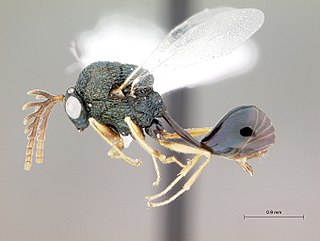
Chalcid wasps are insects within the superfamily Chalcidoidea, part of the order Hymenoptera. The superfamily contains some 22,500 known species, and an estimated total diversity of more than 500,000 species, meaning the vast majority have yet to be discovered and described. The name "chalcid" is often confused with the name "chalcidid", though the latter refers strictly to one constituent family, the Chalcididae, rather than the superfamily as a whole; accordingly, most recent publications (e.g.,) use the name "chalcidoid" when referring to members of the superfamily.

The Mymaridae, commonly known as fairyflies or fairy wasps, are a family of chalcidoid wasps found in temperate, subtropical, and tropical regions throughout the world. The family contains around 100 genera with 1,400 species.

Aprostocetus is a genus of hymenopteran insects of the family Eulophidae. The genus was erected by John O. Westwood in 1833. This very large group of parasitoid wasps has a global distribution.

Parasitoid wasps are a large group of hymenopteran superfamilies, with all but the wood wasps (Orussoidea) being in the wasp-waisted Apocrita. As parasitoids, they lay their eggs on or in the bodies of other arthropods, sooner or later causing the death of these hosts. Different species specialise in hosts from different insect orders, most often Lepidoptera, though some select beetles, flies, or bugs; the spider wasps (Pompilidae) exclusively attack spiders.

The Eucharitidae are a family of parasitic wasps. Eucharitid wasps are members of the superfamily Chalcidoidea and consist of three subfamilies: Oraseminae, Eucharitinae, and Gollumiellinae. Most of the 55 genera and 417 species of Eucharitidae are members of the subfamilies Oraseminae and Eucharitinae, and are found in tropical regions of the world.

The Pteromalidae are a large family of wasps, the majority being parasitoids of other insects. They are found throughout the world in virtually all habitats, and many are important as biological control agents. The oldest known fossil is known from the Early Cretaceous.

The Leucospidae are a specialized group of wasps within the superfamily Chalcidoidea, that are ectoparasitoids of aculeate wasps or bees. They are typically mimics of bees or stinging wasps, often black with yellow, red, or white markings, sometimes metallic, with a robust mesosoma and very strong sculpturing. The hind femora are often greatly enlarged, with a row of teeth or serrations along the lower margin as in Chalcididae. The wing has a longitudinal fold. The female ovipositor is sometimes short, but if not, it is recurved and lies along the dorsal side of the metasoma, a unique feature. The males are also unusual, in the fusion of many of the metasomal segments to form a capsule-like "carapace".

The Tetracampidae are a small family of parasitic wasps in the superfamily Chalcidoidea. They are parasitoids of phytophagous insects, primarily flies. The 44 species in 15 genera are almost entirely absent from the New World.
Signiphoridae is a small family of parasitic wasps in the superfamily Chalcidoidea. The roughly 80 species are placed in four genera.

The Rotoitidae are a very small family of rare, relictual parasitic wasps in the superfamily Chalcidoidea, known primarily from fossils. Only two extant species are known, each in its own genus, one from New Zealand and one from Chile, and little is known about their biology. Females of the Chilean species, Chiloe micropteron, have their wings reduced to tiny bristles. Most fossil species are known from the Late Cretaceous (Santonian) Taimyr amber of Russia and Late Cretaceous (Campanian) Canadian amber, but one species, Baeomorpha liorum is known from the mid Creaceous Burmese amber.

Ixodiphagus hookeri, the tick wasp, is an encyrtid wasp which lays its eggs into ticks. It seems to use a symbiotic bacteria, Wolbachia pipientis, to weaken the tick's immune system.

Thekke Curuppath Narendran was an Indian entomologist specializing in the systematics of parasitic wasps in the superfamily Chalcidoidea (Hymenoptera).

Ormocerinae is a subfamily in the chalcidoid wasp family Pteromalidae.
Monodontomerus obscurus is a parasitic wasp in the family Torymidae. It is native to Europe and has been introduced to North America.

Pirenidae is a family of chalcidoid wasps. It was formerly treated as a subfamily within the family Pteromalidae but is now recognized as a distinct family.
Khutelchalcis is an extinct genus of chalcid wasp, it is the only member of the family Khutelchalcididae. It is only known from a single species, described from the Early Cretaceous Tsagaantsav Formation of Mongolia.

Pelecinellidae is a small family of chalcidoid wasps, formerly treated as the subfamily Leptofoeninae within Pteromalidae. They, like many small chalcidoids, are brilliantly metallic.

Systasidae is a family of chalcidoid wasps. In 2022, this family was described based on an analysis of a combination of molecular, morphological, and life history data.

Eunotidae is a family of chalcidoid wasps. In 2022, this family was described based on an analysis of a combination of molecular, morphological, and life history data.

Heydeniidae is a family of chalcidoid wasps. In 2022, this family was described based on an analysis of a combination of molecular, morphological, and life history data.

















